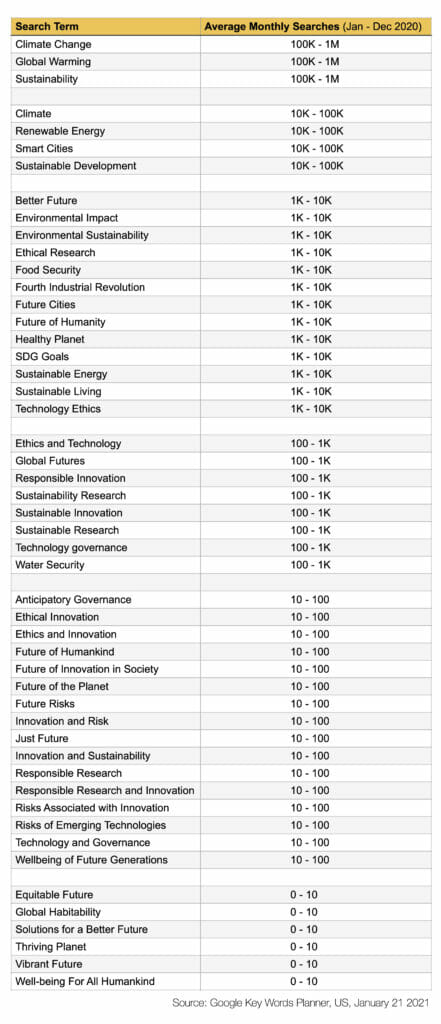If you search for the term “responsible innovation” on YouTube, the chances are that the first video you’ll see is “A Practical Guide to Responsible Innovation.” And yet, since it was published in October 2020, the video has received less than 600 views.
It’s almost as if no-one’s interested in how to innovate responsibly!
Of course, there are many reasons why the number one YouTube video on responsible innovation is failing to attract eyeballs. But this did get me thinking about just how much interest there really is in some of the things I study and talk about outside of my academic bubble — especially because it’s my video that’s not getting the views!
More importantly though, this disconnect got me wondering how much broader interest there is in what we focus on as a College of Global Futures at ASU After all, we do have a commitment to “creating a sustainable, equitable, and vibrant future for everyone.”
One way to get a crude handle on this–and to be honest, it’s one that needs to be taken with a pinch of salt–is to see how often people search for specific terms related to the College using Google. And this is where Google’s Keyword Planner comes in.
The planner is designed to help increase the reach and effectiveness of online ads, and it provides insights into how often people search for a given key word or phrase. And crude as it is (search number ranges are given in factors of 10, so there’s little finesse here), it’s a useful way to gauge interest in a topic.
Plugging “responsible innovation” into the planner indicates that there were on average 100 – 1,000 Google searches for the term per month in 2020 in the US – low enough to explain how the video could both be number one on YouTube, and have so few views! For associated terms like “responsible research and innovation” or “responsible research” there is, apparently, even less interest, with only 10 – 100 searches per month.
But how about other terms that reflect what we do in the ASU College of Global Futures?
To explore this, I plugged into the planner fifty terms that are related to what we research, teach, and have expertise in (using, I admit, a rather crude “this is what occurred to me at the time” methodology). And this is what I got:

The top phrases here — “climate change,” “global warming” and “sustainability” — are a bit of a misleading benchmark, as all of these are phrases that are very widely used in the media, and as a result generate a lot of attention. They do, however, indicate the potential “market” for Google searches in this area.
Moving down to the next tier of search terms, “renewable energy” and “sustainable development” attract a sizable amount of attention in Google searches. I was interested to see “smart cities” landing in this cluster, indicating a reasonably high level of interest in developments here.
Below this, we move to searches in the region of a thousand to ten thousand searches per month which, to be honest, doesn’t seem that many for a country representing over 300 million people. This is where we begin to see search terms that align closely with some of the more specific foci within the college, including “environmental sustainability,” “SDG goals” (sustainable development goals) and “better future.”
“Technology ethics” stands out in this cluster as it indicates an interest in positive futures that goes beyond some of the more mainstream concerns around sustainability and environmental impact. However, the associated term “ethics and technology” — which more broadly encompasses how technologies are developed responsibly and ethically — only receives between 100 – 1,000 searches per month.
What is especially interesting — at least, to me — is the topics in the bottom three clusters. These, despite being important to building more just, equitable, sustainable and vibrant global futures, get very little Google-love. “Future of humankind” only gets between 10 – 100 searches per month, while the number of searches — in the US at least — for “equitable future” or “vibrant future” is somewhere between 0 and 10 per month.
It’s enough to make you wonder how much people really do care about the future!
Of course, there’s a possibility that this analysis says more about how people articulate their future-focused interests and concerns, than it does the nature of those interests and concerns. Nevertheless, it does suggest that we have our work cut out as a College of Global Futures if we’re to ensure we remain relevant and visible in a society where, at least according to Google, relatively few people seem to be interested in their “global futures.”
